Biology
You know that intense pain you get in your fingers when you've been out in the cold for a while? Why does that happen, and why does it get worse when your hands start to warm up or when you run them under lukewarm or warm water? Believe it or not, the pathways are the same as if you coated them in pepper spray.
Allodynia is different; this is when your sibling cries out in pain when you're nice to enough to let them have the last donut. In slightly more scientific terms, allodynia is when the body reacts to non-noxious stimuli as if there were noxious. There are basically two types of allodynia, pain brought on by light touch (static mechanical allodynia) and pain brought on by near ambient temperatures (dynamic allodynia).
For a real world example, let?s go back to shoveling snow during our cold snap. My fingers got very cold, cold enough to activate the TRPA1 and TRPM8 ion channels. Then when I came inside, anything warm ? air, water, a surface, caused much more pain than it should have. This was a result of sensitization of the heat responding TRPV1 channels.
The difference between sensitization and potentiation is in the number of receptors involved. Sensitization means that signaling through one receptor lowers the threshold for a second receptor, while potentiation means repeated signaling through the same receptors will lower its threshold. In both cases, the end result for TRPV1, TRPM8, and TRPA1 is that pains seem exaggerated ? hyperalgesia.
Now for a more unfortunate example of allodynia that seems to involve TRPV1. There is a condition called burning mouth syndrome (BMS). Also known as idiopathic stomatodynia (idio = unknown, pathic = cause disease, stomato= mouth, and dynia = pain). Like the name says, it is a burning, itching, painful mouth disease for which no medical or dental explanation can be found and in which the oral mucosa appears normal. BMS feels like you are chomping on a Carolina Reaper or a Ghost pepper all the time.
People with BMS often report that the pain is reduced when they eat, so perhaps gustatory sensing can overwhelm the pain sensing. And maybe chili peppers will lead the way. A 2012 study indicated that a capsaicin rinse (0.02% capsaicin) reduced the pain of BMS. It decreased the pain for most patients, but didn?t get rid of it for any of them. Ironically, they complained that it burned their mouths ? as if they don?t feel that all the time.
Borsani E, Majorana A, Cocchi MA, Conti G, Bonadeo S, Padovani A, Lauria G, Bardellini E, Rezzani R, & Rodella LF (2013). Epithelial expression of vanilloid and cannabinoid receptors: a potential role in burning mouth syndrome pathogenesis. Histology and histopathology PMID: 24190005
Silvestre FJ, Silvestre-Rangil J, Tamarit-Santafé C, & Bautista D (2012). Application of a capsaicin rinse in the treatment of burning mouth syndrome. Medicina oral, patologia oral y cirugia bucal, 17 (1) PMID: 21743415
Alpizar YA, Boonen B, Gees M, Sanchez A, Nilius B, Voets T, & Talavera K (2014). Allyl isothiocyanate sensitizes TRPV1 to heat stimulation. Pflugers Archiv : European journal of physiology, 466 (3), 507-15 PMID: 23955021
Simonic-Kocijan S, Zhao X, Liu W, Wu Y, Uhac I, & Wang K (2013). TRPV1 channel-mediated bilateral allodynia induced by unilateral masseter muscle inflammation in rats. Molecular pain, 9 PMID: 24377488
- Sometimes, Cold Hurts
Biology concepts ? nature of science, TRPA1, thermoregulation, noxious sensor, chemical sensor, mutation, protein domains "As we acquire more knowledge, things do not become more comprehensible, but more mysterious." Albert Schweitser was an organist...
- Cold Keeps You Warm
Biology concepts ? thermoregulation, TRPM8, vasoconstriction, brown adipose tissue, agonists/antagonists Pep-O Mint was the first Lifesaver flavor, invented in 1912. This was followed quickly by the Lifesaver car in 1918. Built on a Dodge truck chassis,...
- Using Pain To Stop Pain
Biology concepts ? desensitization, habituation, counter irritation, cautery, heat sensing, pain, chronic, acute, analgesia Gout usually attacks middle-aged men and the big toe joint is a favorite spot. But it can occur anywhere and in anyone. The...
- It?s Not Just Chili Peppers That Are Hot
Biology concepts ? cinnamaldehyde, nasal hyperreactivity, piperine, allyl isothiocyanate, eugenol, gingerol, tinyatoxin, osmotic stress, agonist/antagonist The last few years have seen the rise and fall of The Cinnamon Challenge. I can?t tell you why...
- Sweet Suffering
Biology concepts ? nociception, cranial nerve, headache, referred pain, vasodilation, mechanoreceptor Nancy Johnson, a Philadelphia housewife, received a patent for the hand crank ice cream freezer in 1843. She sold the patent for 200 dollars because...
Biology
Capsaicin ? Adding To Or Taking Your Pain
Biology concepts ? hyperalgesia, allodynia, analgesia, sensitization, potentiation, desensitization, habituation, burning mouth syndrome
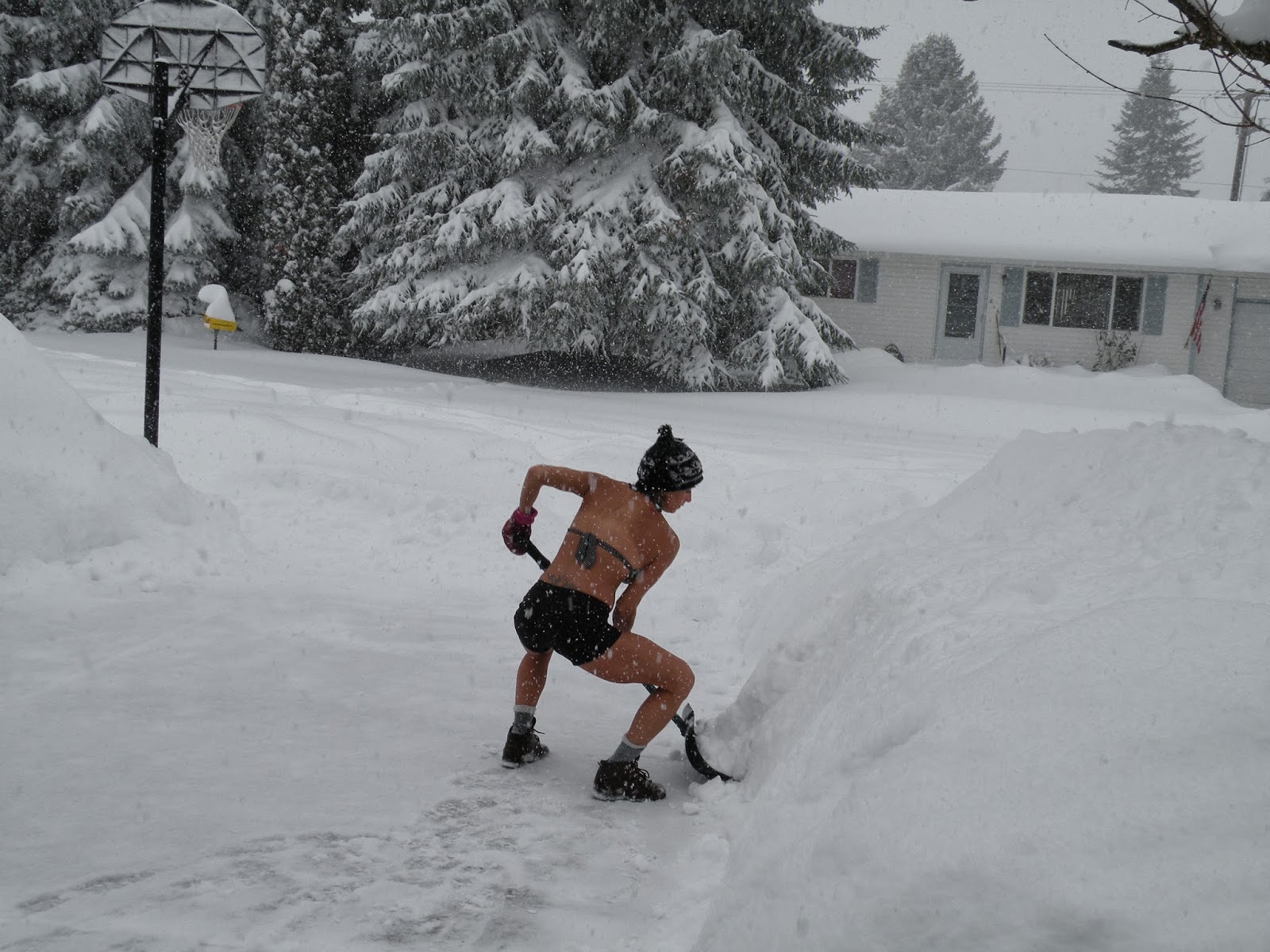 |
| Apparently this is how people shovel snow in the cold climates. I agree with the form; always bend with your knees not your back. But the bikini? Really? I feel like kind of a wimp for talking about my fingers hurting when I stay out too long. |
Across the USA this winter it was snowy and cold. Where I live we had a record snow fall for December-February, and at least two cold snaps (the Polar Express) that drove wind chills to -25 ?F or lower.
These conditions gave me ample time to contemplate the issue of hand and finger pain during and after my many shoveling campaigns. I figured it had something to do with exceptions called hyperalgesia (hyper = excess, and gesia = Latin for pain) and allodynia allo = other, and dynia = Greek for pain). It was the burning pain that helped me put it together with chili peppers.
We have talked about how the capsaicin in hot peppers can activate a receptor called TRPV1 that routinely is used by animals to sense noxious (painful) heat and generate a burning pain. Well, there also happen to be some receptors that work the same way for cold. They're called TRPM8 and TRPA1, and we will talk about them in more detail in the posts to come.
The cold sensors may also relay excess cold as pain, but that doesn?t explain why warming up your hands makes them hurt even more. This is requires the explanations of hyperalgesia and allodynia. Hyperalgesia is a perceived pain that is exaggerated beyond what can be accounted for by the stimulus. This does not include your sibling screaming in horror when you flick the lobe of their ear and they go running to mom claiming that you?re trying to kill them. Hyperalgesia is simply too much pain perceived.
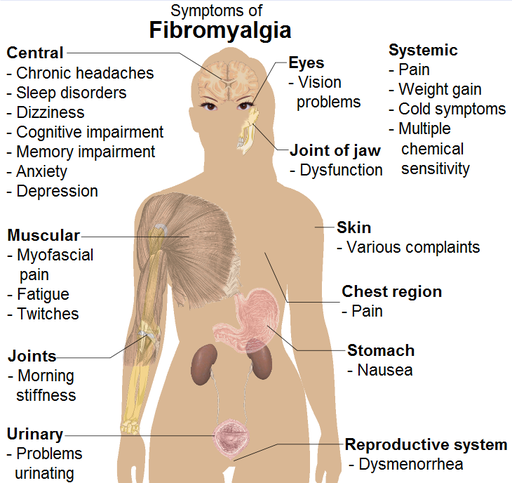 |
| Fibromyalgia is a disease that affects women 80-90% of the time. It is caused by ? well, we don?t know. It may be secondary to hormone changes, due to CNS dysregulation, or maybe even stress. Most believe that it is brought on by a combination of physical and emotional stressors. This cartoon shows SOME of the symptoms that can be manifested. Some people have all, some have only a few, and some have different symptoms. My complaint is that under skin it says ?various complaints.? Since when does having your clothes make you feel enormous pain qualify as a various complaint? |
Tactile (touch) allodynia is rare, it can occur with different kinds of neuropathies, like migraine headaches or a disease called fibromyalgia. Sometimes, even the touch of your clothes on your body can feel very painful, like having a sunburn all over - all the time. In migraines, the pain signals for the headache get mixed up in the central nervous system. This can make even the slightest touch on the face excruciating. And the more often you get migraines, the more likely you are to develop tactile allodynia. Pain is bad, pain when there shouldn?t be any would make me impossible to live with.
In order to explain our cold finger burn when we come inside from the cold out of doors, we need to talk about things like sensitization and potentiation. When one stimulus of a receptor strengthens it response to another stimulus, or when a stimulus to one type of receptor strengthens a stimulus to a second type of receptor ? these are examples of sensitization.
On the other hand, if repeated activation of a receptor strengthens each subsequent firing, then this is demonstration of potentiation. Both of these can occur with the heat-sensing receptor TRPV1.
Sometimes capsaicin + TRPV1 makes the TRPV1 react more strongly to heat or more capsaicin. At other times, activation of another TRP, say TRPM8 by cold or TRPA1 by extreme cold or other noxious stimulus, can make TRPV1 activate more strongly to one of its ligands. These are examples of sensitization.
Since the major sensation perceived after TRPV1 activation is pain, sensitization of the TRPV1 by capsaicin or the activation of other TRPs can result in a larger amount of pain when TRPV1 is activated by acid, heat, or even more capsaicin. More pain from these somewhat painful inputs = hyperalgesia.
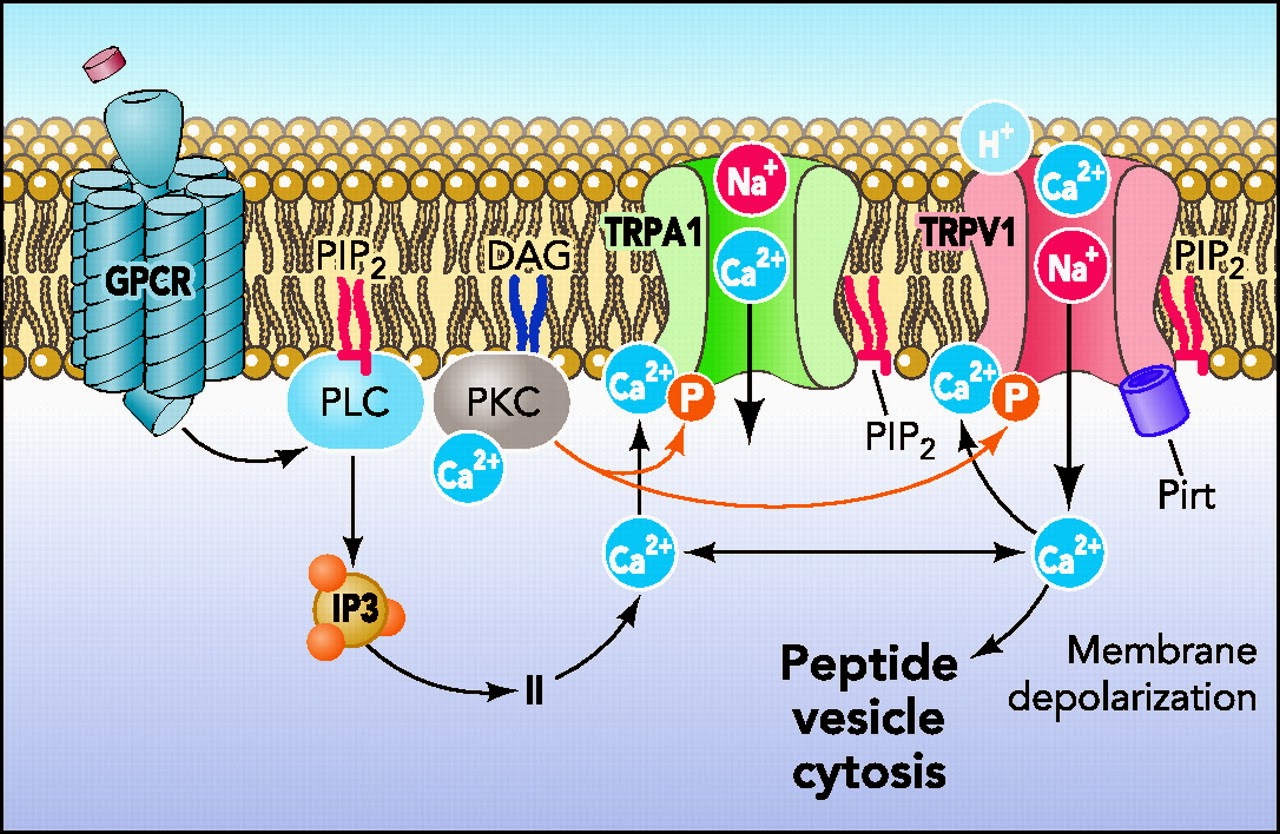 |
| This cartoon shows the capsaicin/heat ion channel TRPV1 and the noxious cold and chemical pain receptor TRPA1. Let?s say that you trigger TRPA1 with noxious cold. This lets in calcium, which activates PKC, This leads to phosphorylation of TRPA1 (P) which then keeps it open. But this may phosphorylate TRPV1 too. Now TRPV1 is ripe to be opened, easier then it normally would be. This is sensitization. |
The TRPV1 response was strengthened due to the synergistic response to a different stimulus. The TRPA1 pain receptors are very often expressed on the same neurons as the TRPV1 receptors, so the common pathways can get mixed up as to stimuli. Activation of the cold channels sensitized the heat channels so that warm was now interpreted as very hot ? burning hot. It took a 5-10 minutes for pain to subside, but it sure seemed like longer.
In a similar way, but through a slightly different mechanism, TRPV1 signals can get amplified by other TRPV1 agonists. If you get punched in the eye really hard, it hurts. Then it swells up and turns colors. This is inflammation. Inflammatory mediators also activate TRPV1 pain channels. If someone touches your eye now ? it hurts a lot more than just touching it before you got punched. This is an example of potentiation. The inflammation signals that activate TRPV1 make it much more excitable and it sends pain signals much more easily.
Another example of this was shown in a 2013 paper. Allyl isothiocyanate (AITC) from wasabi or onions binds can make hot food seem hotter. This applies to both hot meaning spicy, and hot meaning the opposite of cold. Scientists knew that AITC could activate TRPA1 pain sensors, so they thought AITC was sensitizing the TRPV1 through action on TRPA1, but this study showed that AITC can activate TRPV1 directly. Therefore, AITC may make TRPV1 active based on both sensitization and potentiation.
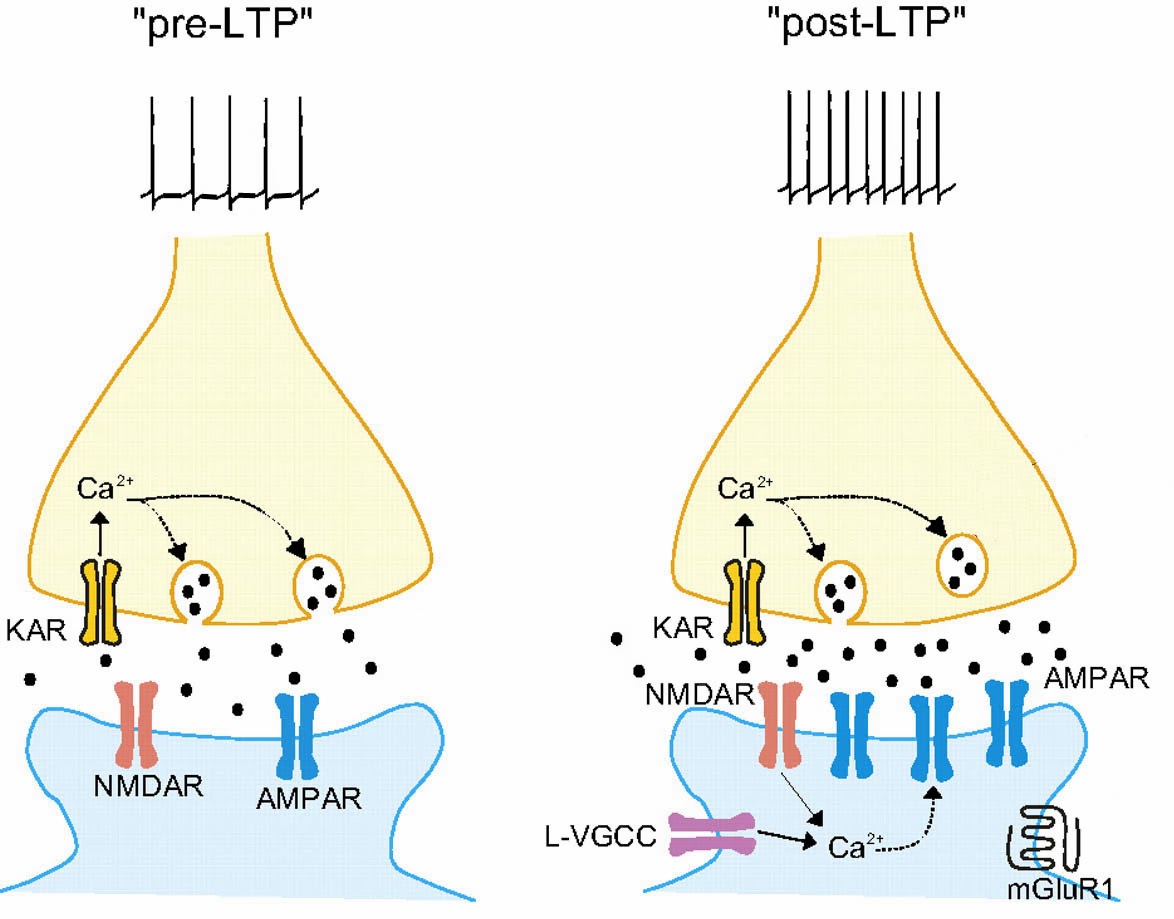 |
| This cartoon tries to illustrate potentiation as different from sensitization. Potentiation is important learning, you see there is a higher level of neurotransmitters (dots) in the cleft (space) after potentiation. Repeated firing strengthens the signal and makes it easier to fire the neuron because there is more neurotransmitter and more receptors. |
What about allodynia ? feeling pain when the stimulus shouldn?t be painful at all? TRPV1 and capsaicin can do that as well. This is also seen in my cold finger story. Sometimes, just coming inside and sitting down can make my fingers start hurting more and more. Room temperature shouldn?t cause pain at all; we have said before that TRPV1 is activated by heat only above 43?C. This would mean that room temperature must be TRPV1-mediated allodynia.
Another 2013 study showed this in another model. Rats with inflammation in one masseter muscle (the big muscles in your cheeks that help you chew) could bring pain on chewing ? in the opposite masseter muscle. This was blocked by TRPV1 antagonist, so it was definitely mediated through TRPV1, though they are the TRPV1 receptors in the central nervous system, not those in the muscles. The pain on chewing should have been only on the inflamed side, but it was on the other side too ? that?s a form of allodynia.
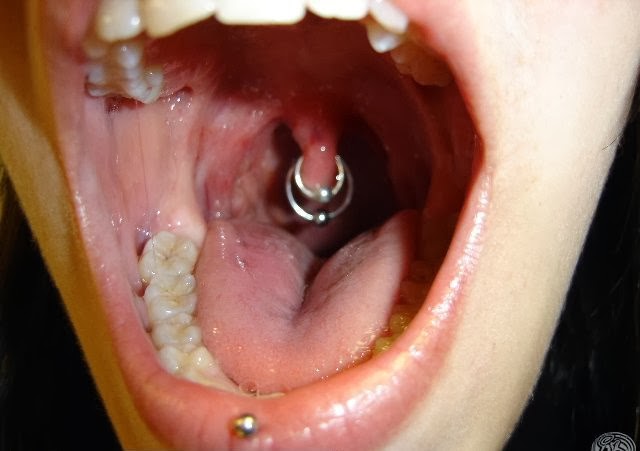 |
| I was looking for a picture to illustrate burning mouth syndrome. This is what I found. People pierce their uvulas?! The gag reflex would be unbearable, and it would hang down at night and reduce your airway. If burning mouth syndrome has no known cause, what causes this? ? true central nervous system dysreguation. I think I?d rather have burning mouth syndrome. |
BMS can be secondary to some diseases, but not caused by those diseases. It can last for months on end and then just go away, only to return later. There are different types, depending on whether you feel OK in the morning and then it gets worse as the day goes on, or whether it can come and go on a day to day basis.
So why talk about BMS in a story of TRPV1? Well, a 2013 paper shows that people with BMS tend to have more TRPV1 bearing neurons in their mouths. These same patients tended to have more of one type of cannabinoid receptor and less of another in their mouths as well. We know that some endocannabinoids can interact with TRPV1 capsaicin receptors, so it looks like the systems overlap here. And we also said before that supertasters have more TRPV1 neurons, so they would be more likely to get BMS.
The higher the number of TRPV1 ion channels, the more pain the patients reported, so it really sounds like these pain receptors are involved in BMS. But they might be the salvation as well.
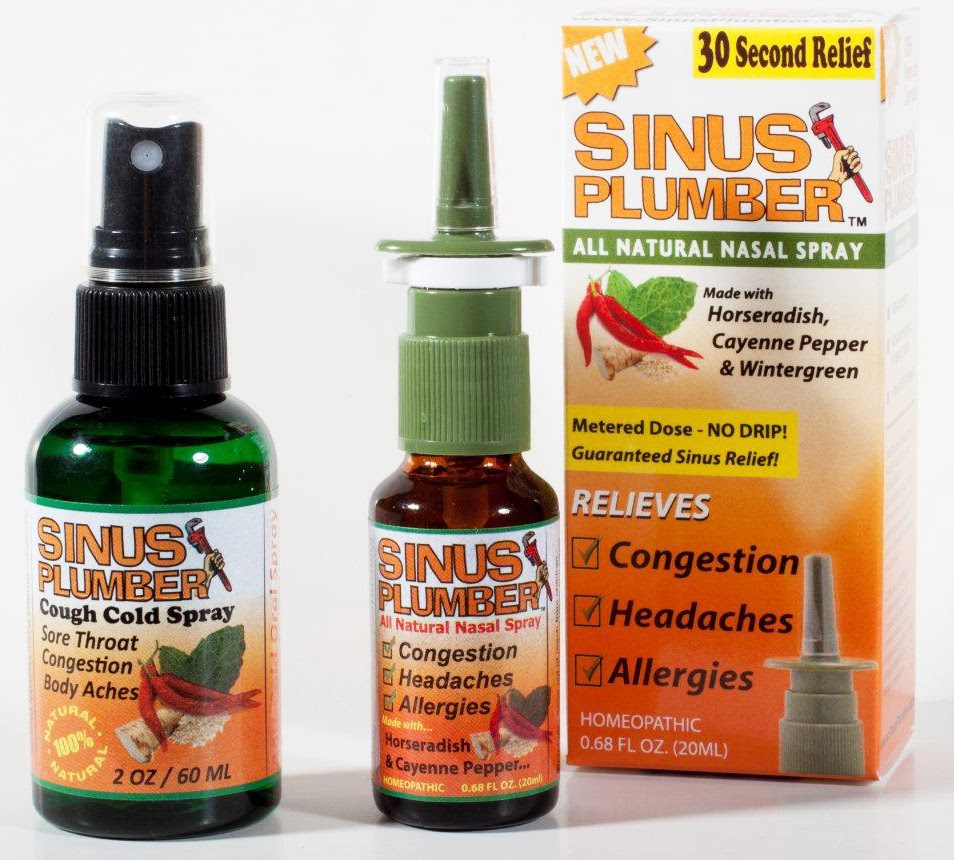 |
| Here is an example of a capsaicin spray for reducing mouth pain. There is also one for nasal congestion. I, personally, would stay away from that one. These are based on the idea that some capsaicin can reduce pain in the mouth ? desensitization. And it has been studied in burning mouth syndrome with some success. We'll talk a lot more about it next week. |
An earlier review also showed that some studies showed a decrease in BMS symptoms via a topical capsaicin preparation. They just didn?t like the taste. This opens up a whole new bunch of questions. How can you use capsaicin to relieve burning pain? It causesburning pain!!
You use pain to stop pain ? huh? You ponder that for a week.
Borsani E, Majorana A, Cocchi MA, Conti G, Bonadeo S, Padovani A, Lauria G, Bardellini E, Rezzani R, & Rodella LF (2013). Epithelial expression of vanilloid and cannabinoid receptors: a potential role in burning mouth syndrome pathogenesis. Histology and histopathology PMID: 24190005
For more information or classroom activities, see:
I looked for good websites on sensitization and potentiation, but none are very good at explaining them in this situation, most are for learning pathways.
Pain from warm after cold ?
http://www.thenakedscientists.com/HTML/questions/question/1467/
http://www.wildsnow.com/661/cold-hands-the-torture-cure/
Fibromyalgia ?
http://www.mayoclinic.org/diseases-conditions/fibromyalgia/basics/definition/con-20019243
http://www.fmnetnews.com/fibro-basics/symptoms
http://www.huffingtonpost.com/stanford-center-for-sleep-sciences-and-medicine/sleep-tips_b_4770369.html
http://www.niams.nih.gov/health_Info/Fibromyalgia/default.asp
http://fmaware.org/PageServerded3.html?pagename=fibromyalgia
Burning mouth syndrome -
http://www.nidcr.nih.gov/OralHealth/Topics/Burning/BurningMouthSyndrome.htm
http://www.aafp.org/afp/2002/0215/p615.html
http://www.google.com/url?sa=t&rct=j&q=&esrc=s&source=web&cd=6&sqi=2&ved=0CFkQFjAF&url=http%3A%2F%2Fwww.ada.org%2Fsections%2Fscienceandresearch%2Fpdfs%2Fpatient_53.pdf&ei=2MIHU-CgEcngrQHakoGIAQ&usg=AFQjCNFZAo5Dr5TEIt4Ns45D8zIk7Xb8AA&sig2=xjQsxltnlrig-FowGrUtcQ
http://abcnews.go.com/Health/PainManagement/story?id=4274230
http://www.webmd.com/oral-health/burning-mouth-syndrome
- Sometimes, Cold Hurts
Biology concepts ? nature of science, TRPA1, thermoregulation, noxious sensor, chemical sensor, mutation, protein domains "As we acquire more knowledge, things do not become more comprehensible, but more mysterious." Albert Schweitser was an organist...
- Cold Keeps You Warm
Biology concepts ? thermoregulation, TRPM8, vasoconstriction, brown adipose tissue, agonists/antagonists Pep-O Mint was the first Lifesaver flavor, invented in 1912. This was followed quickly by the Lifesaver car in 1918. Built on a Dodge truck chassis,...
- Using Pain To Stop Pain
Biology concepts ? desensitization, habituation, counter irritation, cautery, heat sensing, pain, chronic, acute, analgesia Gout usually attacks middle-aged men and the big toe joint is a favorite spot. But it can occur anywhere and in anyone. The...
- It?s Not Just Chili Peppers That Are Hot
Biology concepts ? cinnamaldehyde, nasal hyperreactivity, piperine, allyl isothiocyanate, eugenol, gingerol, tinyatoxin, osmotic stress, agonist/antagonist The last few years have seen the rise and fall of The Cinnamon Challenge. I can?t tell you why...
- Sweet Suffering
Biology concepts ? nociception, cranial nerve, headache, referred pain, vasodilation, mechanoreceptor Nancy Johnson, a Philadelphia housewife, received a patent for the hand crank ice cream freezer in 1843. She sold the patent for 200 dollars because...
